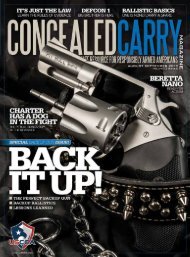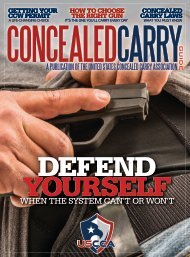Download This Issue - US Concealed Carry
Download This Issue - US Concealed Carry
Download This Issue - US Concealed Carry
You also want an ePaper? Increase the reach of your titles
YUMPU automatically turns print PDFs into web optimized ePapers that Google loves.
Walther_PPS_GunWOrld 5/27/08 1:27 PM Page 1<br />
The new Walther PPS-Polic Pistol Slim provides<br />
the best of both concealment and comfort by<br />
packing Walther innovation and your choice of<br />
two calibers into an unbelievable 1.04 inch<br />
profile. Available in both 9mm and .40 S&W, the<br />
PPS packs in more power.<br />
of the history and issues pertaining<br />
to the Second Amendment to the <strong>US</strong><br />
Constitution can be an eye opener.<br />
The scholarly debate was resolved<br />
years ago. Scholars now generally agree<br />
that the Second Amendment’s guarantee<br />
of the right to keep and bear arms<br />
referred to individual’s private arms,<br />
used for the purpose of protecting<br />
themselves, their families, their communities,<br />
their state, and their country—and<br />
as a last resort to protect<br />
themselves from the tyranny of their<br />
own government. Our Founders considered<br />
private arms both an individual<br />
right and a moral obligation of citizenship.<br />
Since 1980 there have been over<br />
60 published law-journal articles, and<br />
all but four of them find the individualrights<br />
view compelling. Of the four articles<br />
which take the states’-rights view,<br />
two were written by lawyers on the payroll<br />
of Handgun Control, Inc. or its sister<br />
organizations, one by a non-lawyer<br />
lobbyist of HCI, and one by an anti-gun<br />
politician. 8<br />
The plain meaning of the words of<br />
the Second Amendment are even more<br />
clear when one consults the hundreds<br />
of references to them by the Founders.<br />
Here are a few examples:<br />
“Arms in the hands of individual citizens<br />
may be used at individual discretion...in<br />
private self-defense.” — John<br />
Adams, A Defense Of The Constitution<br />
(1787-88).<br />
“The Constitution shall never be<br />
construed to prevent the people of the<br />
United States who are peaceable citizens<br />
from keeping their own arms.” —<br />
Samuel Adams (1788).<br />
“As civil rulers, not having their duty<br />
to the people before them, may attempt<br />
to tyrannize, and as the military forces<br />
which must be occasionally raised to<br />
defend our country, might pervert their<br />
power to the injury of their fellow citizens,<br />
the people are confirmed by the<br />
article [2nd Amendment] in their right<br />
to keep and bear their private arms.”<br />
— Trench Coxe, “Remarks on the First<br />
Part of the Amendments to the Federal<br />
Constitution,” Philadelphia Federal<br />
Gazette, June 18, 1789, p. 2, col. 1.<br />
In response to a proposal for gun registration:<br />
“Absolutely not! If the people<br />
are armed and the federalists do not<br />
know where the arms are, there can<br />
never be an oppressive government.”<br />
— George Washington.<br />
Under the laws of 18th century<br />
England, most of the thirteen colonies,<br />
and the United States for the first century<br />
of its existence, able bodied males<br />
age 16 to 60 were not only permitted,<br />
but required to possess military type<br />
arms (“assault weapons”). The same<br />
Congress that wrote the Bill of Rights<br />
enacted the Militia Act of 1790 that so<br />
stated. Current federal law also states:<br />
“The militia of the United States consist<br />
of all able-bodied males at least 17 years<br />
of age…The classes of the militia are (1)<br />
the organized militia, which consists of<br />
the National Guard…and (2) the unorganized<br />
militia, which consist of members<br />
of the militia who are not members<br />
of the National Guard…” 9<br />
The National Guard, which didn’t exist<br />
for the first century of this country’s<br />
existence, was specifically raised under<br />
Congress’s Constitutional power<br />
to “raise and support armies,” and not<br />
under its power to “provide for organizing,<br />
arming and disciplining the militia.”<br />
Why? Because an army can be sent<br />
abroad (as it has several times), while<br />
the militia can be used only to protect<br />
the home ground against invaders.<br />
(House Report No. 141, 73rd Congress,<br />
1st Sess. (1933), pp.2-5.) Furthermore,<br />
the Second Amendment could not refer<br />
to the arms of the National Guard, since<br />
the Guard’s weapons are owned by the<br />
federal government. 10<br />
The <strong>US</strong> Supreme Court has in all cases<br />
dealing with the Second Amendment<br />
affirmed the rights of individuals to<br />
keep and bear their private arms. For<br />
example, in <strong>US</strong> v. Cruickshank, Presser v.<br />
Illinois, and other post-Civil War cases,<br />
the Supreme Court clearly recognized<br />
that the Second Amendment protected<br />
individual rights to keep and bear arms,<br />
but rejected the defendant’s cases on<br />
the now discredited grounds that the<br />
Fourteenth Amendment didn’t extend<br />
the protection of the Bill of Rights to actions<br />
by the states. 11<br />
The following are examples of cases<br />
in which the Court explicitly recognized<br />
that the Second Amendment clearly<br />
guarantees individuals the right to their<br />
private arms:<br />
28<br />
<strong>US</strong>CONCEALEDCARRY.COM n CONCEALED CARRY MAGAZINE n JULY 2008
















